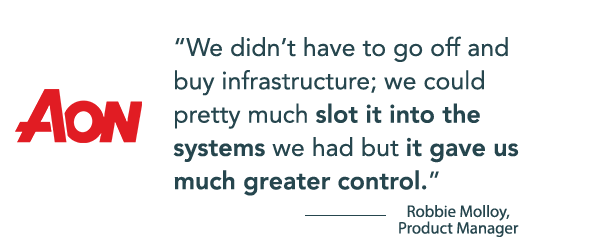The phrase "time is money" is truer than ever today.
From mortgage approvals to insurance policies, financial institutions and insurance companies are under pressure to leave behind manual, error-prone processes in favor of streamlined, intelligent systems.
Take global insurance leader Aon, for example. The company previously relied on emails, spreadsheets, and paper-heavy workflows that slowed decision-making and made auditability difficult.
By adopting a modern digital automation platform like FlowForma, Aon was able to standardize processes, reduce implementation time from months to days, and gain clearer oversight across business units.
This example illustrates the power and versatility of automated underwriting systems, which range from rules-based logic and predictive models to machine learning and hybrid systems, with many platforms now incorporating AI-driven agents for real-time, context-aware decisions.
In this blog post, we’ll explore the what, why, and how of automated underwriting, providing a clear roadmap for implementing these systems effectively in your business.
What is Automated Underwriting?
Automated underwriting leverages technology—such as AI-powered process automation, algorithms, predefined rules, and data analytics—to assess applications for loans, insurance, or financial services.
AI enhances this process by identifying patterns, assessing risk more accurately, and making faster, data-driven decisions, ultimately improving efficiency and reducing manual intervention.
When a customer applies for a personal loan, car insurance, or even a mortgage, their borrower's information is fed into an automated underwriting platform. The system instantly checks their data against established underwriting criteria like credit score thresholds, employment history, or claims records and delivers a decision: approve, deny, or flag for further review.
Unlike manual underwriting, which relies heavily on individual judgment and paper-based processes, automated underwriting uses technology to standardize and speed up risk evaluation while also improving accuracy.
🚀 Case in point: Aon
Aon, one of the world’s largest insurance brokers, needed a solution that could plug directly into its Microsoft environment. Using FlowForma’s AI capabilities and SharePoint Online, they digitized 30+ underwriting workflows—saving hours of manual work and reducing their reliance on development resources.

Aon Insurance was able to improve its processes because it was easy to integrate its existing tech stack into Flowforma.
What is the Need for Automating Manual Underwriting Processes?
 Top Challenges of Manual Underwriting
Top Challenges of Manual Underwriting
Financial institutions are facing unprecedented pressure from multiple fronts.
Today, customers expect everything to happen fast. So when it takes a week or more to hear back on something as simple as an insurance policy or loan approval, they’re not just disappointed—they’re going elsewhere.
And it’s not just a speed problem; manual underwriting also struggles with human errors.
Here are a few core reasons automation of underwriting processes is essential:
- Speed and scalability: Manual reviews can take days or weeks; automated systems deliver results in minutes.
- Consistency: Automation ensures uniform decision-making and removes bias or variance.
- Accuracy: Reduces human errors in data entry and assessments.
- Compliance: Automated workflows maintain clear audit trails and regulatory alignment.
- Competitiveness: Enables institutions to match or exceed digital-first competitors.
What are the Types of Automated Underwriting Systems?
Automated underwriting systems use varying levels of intelligence to assess applications efficiently. FlowForma supports all key approaches—enhancing each with the power of Agentic AI for smarter, real-time decision-making.
1. Rules-based systems
These systems operate on a predefined set of “if-then” logic rules to make decisions. For example: If applicant age < 30 and no medical history, then approve automatically.
✅ Use case: Best suited for straightforward, repetitive applications with low-risk profiles.
2. Predictive model systems
These systems use statistical models trained on large historical datasets to forecast risk. They analyze past patterns to predict the likelihood of future events (like claim probability or fraud risk).
✅ Use case: Ideal for long-term risk analysis and scoring applicants based on historical trends.
3. Machine learning systems
Machine learning (ML) systems go beyond fixed rules and predictive models by continuously learning from data. They detect complex, non-obvious patterns to assess risk dynamically and improve over time.
✅ Use case: Powerful in uncovering subtle indicators of risk and adapting to changing data—though resource-intensive to set up.
4. Hybrid systems
Hybrid systems combine rules-based logic, predictive models, and machine learning. They route applications to the most appropriate method based on complexity, risk level, or available data.
✅ Use case: Best for organizations that need both efficiency for routine cases and intelligence for complex ones—at scale.
5. What Agentic AI adds to underwriting?
As a next-generation underwriting technology, Agentic AI elevates each of the aforementioned approaches by acting as an embedded, decision-ready underwriter. With just one prompt, it evaluates risk, eligibility, and policy guidelines—delivering expert-level decisions in real time.
Key features include:
✅ Prompt-driven logic: Instantly generates decisions based on simple, custom-tailored prompts.
✅ Modular deployment: Seamlessly integrates at any point in the underwriting lifecycle: intake, triage, or final decision.
✅ Contextual intelligence: Immediately understands applicant data, underwriting context, and policy rules to ensure compliance and consistency.
Agentic AI transforms underwriting from rule-following to intelligent, context-aware decision-making—delivering speed, accuracy, and adaptability at every step.
What are the Benefits of Automated Underwriting?
 Benefits of automated underwriting
Benefits of automated underwriting
Automating underwriting processes comes with several key benefits. Here are a few:
1. Speed and efficiency
Automated loan underwriting platforms can handle far more applications with fewer resources because the system cuts down processing time from days to seconds. A small team that once processed 100 applications a week can now comfortably handle 500 or more without working overtime or sacrificing accuracy.
2. Consistency and accuracy
Human underwriters, as skilled as they are, can interpret the same application in slightly different ways. Automated underwriting systems, however, bring consistency into the process. This consistency not only reduces bias and improves fairness but also supports compliance.
3. Improved risk management
A powerful benefit of underwriting process automation is in its ability to improve how institutions assess risk. Predictive algorithms and machine learning models can reveal patterns even seasoned professionals might overlook.
4. Better customer experience
As per a study by McKinsey, automating the underwriting process allows lending services to deliver faster, data driven decisions while achieving cost savings by reducing administrative expenses by 20-30%.
Applicants receive near-instant feedback on their status, including evaluations of their borrower's credit history and for lenders, this increased speed often leads to higher conversion rates, stronger customer trust, and fewer drop-offs during the application process.
💡 Pro Tip: FlowForma's guide to workflow automation in insurance offers in-depth insights into how insurers can leverage automation to streamline operations and enhance customer experience.
5. Smarter use of human resources
Another underrated advantage of automated underwriting is how it frees up human underwriters to do what they do best: handle complex, nuanced cases that require judgment, empathy, and deep experience.
📑 Also read: Looking to streamline HR processes for your organization? Read FlowForma’s complete guide to HR automation to know more.
Want to learn more about the benefits of process automation? Discover how Aon has transformed its operations with seamless process automation.
How Does Automated Underwriting Work?
Automated underwriting follows a structured process that transforms raw applicant data into informed decisions in five steps:
Step one: Data collection and verification
Instead of relying on customers to manually submit documents and then waiting days for a processor to open, check, and verify them, an automated underwriting platform pulls information from multiple sources in real time.
Tools like FlowForma use customizable forms to streamline the collection of essential information directly from applicants. These forms are dynamically adapted based on the applicant's responses, ensuring that only the relevant fields are presented, which helps reduce errors or missing information.
Step two: Rules application
Once the data is in, the system applies pre-set business rules.
Example: If an applicant’s credit score is over 750, income is steady, and debt-to-income ratio is low, the system approves them automatically. No human input is needed.
You can build custom rule-based underwriting workflows in minutes using FlowForma’s AI Copilot — just type or speak your instructions.
Step three: Risk assessment
Underwriting often requires more than just basic rule checks; it demands deeper insights into patterns, historical data, and subtle risk indicators that traditional systems might miss, utilizing relevant data.
That’s where FlowForma’s AI Agents comes in, surfacing intelligent recommendations and potential red flags based on historical outcomes and patterns. This ensures even subtle risk signals are considered, enhancing decision accuracy.
Step four: Decision generation
After evaluating data, the system determines whether to approve, deny, or refer an application for manual review—a triage approach that ensures speed without sacrificing oversight.
Through FlowForma Insights, insurers gain real-time visibility into workflows, can track bottlenecks, assess risk trends, and monitor key performance indicators. This level of transparency supports smarter, faster decision-making, while maintaining control over complex or high-risk cases.
 Streamline Underwriting Decisions with FlowForma: Faster, Smarter, More Accurate.
Streamline Underwriting Decisions with FlowForma: Faster, Smarter, More Accurate.
Step five: Documentation
An often underrated part of automated underwriting is documentation but it’s critical. Every decision made by the system needs to be traceable: what data was used, including financial statements, what rules were triggered, and why an application was approved or flagged.
FlowForma’s automated document generation makes this seamless by auto-generating decision logs, reports, and loan applications summaries as part of the workflow, including all the information required. So when regulators come calling or customers request a breakdown, you’re not scrambling, the paper trail is already built in.
Automate your Underwriting Processes Effortlessly with Flowforma
Underwriting has always required deep thinking, sound judgment, and an eye for risk. But today, it also demands speed. FlowForma helps underwriters strike that balance, streamlining the process from intake to decision while reducing manual work.
Learn how Aon, Marsh McLennan, and Protection and Prosperity Financial Services are automating insurance workflows to drive operational excellence in this recent webinar.
AI-powered rule-based routing
With FlowForma’s AI Copilot, you can build or update underwriting workflows in real time. Besides, you can automatically route applications to the right team based on factors like policy type, risk score, or transaction value. This ensures high-volume queues move swiftly while maintaining precision in decision-making.
Intelligent Decision-Making with Agentic AI
FlowForma’s Agentic AI takes underwriting automation to the next level by embedding real-time, expert-level intelligence directly into your workflows. This AI agent understands underwriting guidelines, risk parameters, and applicant data—responding instantly based on your custom prompts.
Whether placed at intake, triage, or final decision stages, Agentic AI delivers accurate, context-aware decisions, reducing manual effort and accelerating approvals without compromising on compliance or quality.
Flowfroma’s Agentic AI delivers smart, compliant, and efficient underwriting decisions—automated and in real-time.
Built-in compliance and audit readiness
Every FlowForma workflow automation suite comes audit-ready, with features like e-signatures, version control, document snapshots, and a complete activity log. This makes it easy to stay compliant and quickly respond to internal or regulatory reviews.
Seamless system integrations
FlowForma integrates effortlessly with Microsoft 365 tools like Outlook, Excel, and SharePoint, as well as external databases and APIs. That means underwriters can verify data, pull information, and update records all in one centralized view, without toggling between platforms.
 .
.
FlowForma seamlessly integrates with thousands of systems
Ready to adapt automated underwriting for your business and lead with confidence?
Sign up for a 7-day free trial today to see firsthand how Flowforma can help your organization achieve faster, more efficient underwriting.

 By
By 



